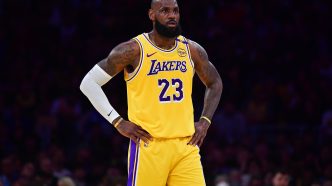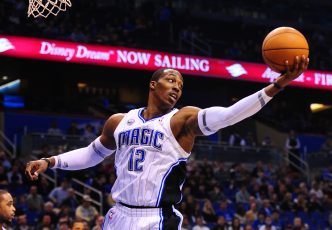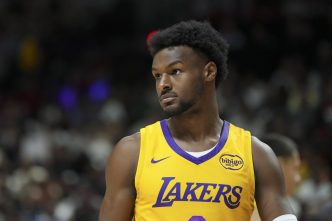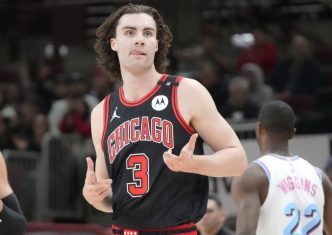In the high-stakes world of the NBA playoffs, every move by a superstar like LeBron James is scrutinized. After the Los Angeles Lakers’ first-round exit against the Minnesota Timberwolves in the 2025 Western Conference playoffs, reports surfaced that LeBron James suffered a Grade 2 MCL sprain in his left knee during a collision with Donte DiVincenzo in Game 5.
However, a post on X has sparked speculation that the injury may have been exaggerated or even fabricated, igniting a firestorm of debate among fans and analysts. The post in question asked, “But we’re supposed to believe he suffered a GRADE 2 MCL SPRAIN in Game 5???” This article explores the possibility that LeBron James could have faked or overstated his injury, examining the evidence, context, and motivations behind such a claim.
The Injury Report and Initial Context
According to multiple reports, including one filed to ESPN.com, LeBron James sustained a Grade 2 MCL sprain in his left knee during a collision with Donte DiVincenzo in Game 5 of the Lakers’ first-round series against the Timberwolves. The injury reportedly occurred with just under nine minutes left in the game, after which LeBron briefly left the court for 1 minute and 20 seconds before returning to finish the final 7 minutes and 23 seconds of play. Despite the injury, LeBron showed no significant signs of discomfort, even executing high-level athletic plays, including a notable move at the end of the game that caught the attention of skeptics.
A Grade 2 MCL sprain is a partial tear of the medial collateral ligament, typically requiring 4-6 weeks of recovery, depending on the severity and treatment. For an athlete of LeBron’s caliber, such an injury would likely cause visible discomfort, limited mobility, or adjustments in playing style. Yet, posts on X, including the one sparking this discussion, point out that LeBron’s performance in the final minutes of Game 5 appeared unaffected, raising questions about the legitimacy of the injury claim.
The Case for a Faked or Exaggerated Injury
The skepticism voiced in the X post centers on LeBron’s ability to continue playing at an elite level after the reported injury. Critics argue that a Grade 2 MCL sprain would have visibly impacted his movement, especially in a high-intensity playoff game. The X user’s incredulity—“But we’re supposed to believe he suffered a GRADE 2 MCL SPRAIN in Game 5???”—is echoed by others who point to specific moments in the game where LeBron appeared to move fluidly, including a highlight-reel play that showcased his athleticism. One post on X questioned, “Did LeBron injure his knee during or after the game? Because medically, how does he move LIKE THIS at the end of the game?” alongside a video clip of LeBron’s late-game heroics.
Further fueling suspicion is the timing of the injury report. The news broke after the Lakers’ elimination, leading some to speculate that the injury was used as a post-hoc explanation for the team’s loss. Another X post claimed, “LeBron’s people & media really spent all day tryna push a complete lie,” suggesting that the injury narrative was crafted to deflect criticism from LeBron’s performance or the Lakers’ playoff shortcomings. The fact that LeBron played through the injury without noticeable limitations—returning after a brief absence and finishing the game—lends credence to the idea that the sprain may have been less severe than reported or entirely fabricated.
LeBron has faced accusations of embellishing injuries in the past. For example, a separate X post from April 24, 2025, referenced by Barstool Sports, accused LeBron of “faking an injury while peeking for a foul call” in an earlier game, suggesting a pattern of exaggerating physical ailments for strategic purposes. Critics argue that LeBron, known for his basketball IQ and media savvy, might use injury reports to shape narratives, manage expectations, or deflect blame after a disappointing series.
Possible Motivations for Faking an Injury
If LeBron did exaggerate or fake the MCL sprain, several motivations could explain such a move:
- Protecting His Legacy: At 40 years old, LeBron remains under intense scrutiny as one of the greatest players in NBA history. A first-round playoff exit could invite criticism about his declining performance or leadership. By citing a Grade 2 MCL sprain, LeBron and his camp could shift the narrative, framing the loss as a result of physical limitations rather than a failure to deliver in the clutch.
- Team Dynamics: The Lakers’ 2024-25 season was marked by high expectations but inconsistent play. An injury narrative could serve to deflect blame from coaching decisions, roster construction, or team chemistry issues, placing the focus on LeBron’s physical sacrifice instead.
- Future Contract Negotiations: LeBron is reportedly expected to stay with the Lakers following the playoff loss, but an injury could provide leverage in contract discussions or influence the team’s offseason strategy, such as pursuing additional star players to support him.
- Media Management: LeBron has long been adept at controlling his public image. Announcing an injury after a series loss could garner sympathy from fans and media, reinforcing his reputation as a warrior who plays through pain.
Counterarguments: Why the Injury Might Be Legitimate
While the X post and others cast doubt on the injury, there are reasons to believe the Grade 2 MCL sprain was genuine. LeBron’s ability to finish the game doesn’t necessarily disprove the injury. Elite athletes often play through significant pain, especially in the playoffs, aided by adrenaline, medical treatment, or taping. The brief 1-minute-20-second absence from the game could indicate an on-the-spot evaluation by the Lakers’ medical staff, who cleared him to return after determining the injury wasn’t severe enough to sideline him.
Medical experts note that Grade 2 MCL sprains vary in severity. A mild Grade 2 sprain might allow an athlete like LeBron, with access to top-tier medical care and conditioning, to continue playing with minimal visible impact, especially in a must-win game. The collision with DiVincenzo, described in multiple reports, provides a clear mechanism of injury, and the fact that the news was first reported by credible sources like ESPN’s Dave McMenamin (
@mcten) adds legitimacy to the claim.
Additionally, LeBron’s history of durability doesn’t preclude him from sustaining injuries. At 40, even minor injuries can have a cumulative effect, and the reported sprain could explain any subtle performance dips that weren’t immediately obvious to fans watching the game.
The Role of Social Media in Shaping the Narrative
The X post questioning LeBron’s injury reflects the broader role of social media in amplifying skepticism and shaping public perception. Platforms like X allow fans to dissect every play, injury report, and media narrative in real time, often challenging official accounts with their own interpretations. In this case, the viral nature of the post—“But we’re supposed to believe he suffered a GRADE 2 MCL SPRAIN in Game 5???”—has fueled a broader conversation, with some users accusing LeBron of orchestrating a “lie” to protect his ego, while others defend his toughness and question the motives of his critics.
The polarized sentiment on X highlights the challenge of discerning fact from speculation. While some posts provide compelling visual evidence, like clips of LeBron’s late-game athleticism, they don’t definitively disprove the injury. Conversely, official reports from ESPN and other outlets carry weight but lack transparency about the medical evaluation process, leaving room for doubt.
Conclusion
The question of whether LeBron James faked his Grade 2 MCL sprain in Game 5 of the 2025 Western Conference playoffs remains unanswered. The X post sparking this debate captures a sentiment shared by some fans: disbelief that a player of LeBron’s caliber could sustain a significant injury yet perform at such a high level. The collision with Donte DiVincenzo, LeBron’s brief absence, and his subsequent return provide a plausible basis for the injury report, but his ability to finish the game without visible limitations raises legitimate questions. Whether motivated by a desire to protect his legacy, deflect blame, or manage his public image, the possibility that LeBron exaggerated or fabricated the injury can’t be ruled out without further medical evidence.
Ultimately, the truth may lie in a gray area: LeBron could have sustained a minor injury that was amplified in reports to serve a narrative, or he may have played through legitimate pain in a testament to his resilience. As fans continue to debate on X and beyond, this controversy underscores the intense scrutiny faced by one of basketball’s greatest icons.








